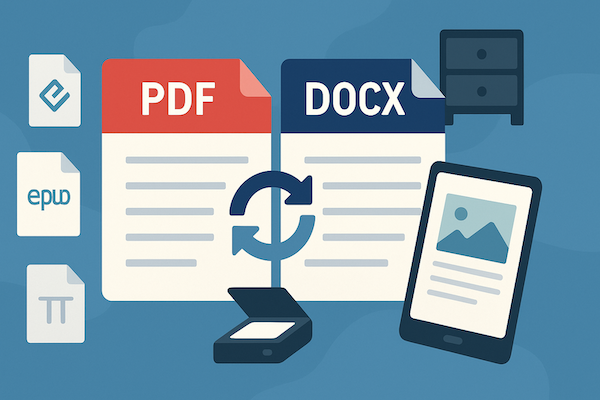The Beginner's Guide to Website Development: From Web Page Creation to PDF Tools
Creating a website is one of the most valuable steps both individuals and businesses can take to stand out in today's digital landscape. Whether you're building a personal portfolio, launching an online store, or establishing a brand presence, understanding the basics of website development can empower you to make informed choices and create effective digital spaces that deliver value and results.
What Is Website Development?
Website development refers to the technical process of building and maintaining websites, including both the visual interface and the invisible infrastructure that powers it. This profession involves many technical and design abilities, like writing code, structuring content, setting up servers, managing databases, and ensuring that everything works seamlessly across different devices. While modern tools have made it easier to launch a site without coding, development still relies heavily on technical know-how, especially when custom features or high-performance requirements are involved.
- The Missing Link: This e-book covers the fundamentals of Web development and programming.
- What Is Web Development? If you're considering a career in Web development, read this guide to learn more about what you might be getting into.
- Web Developer Professional Profile: Take a closer look at what Web developers do and what their workdays are like.
What Is Web Design?
Web design focuses on a site's visual presentation and user experience. While development is about functionality, design shapes what users see and how they interact with it, which includes the layout, color palettes, typography, imagery, and overall aesthetics. Though these roles sometimes overlap, Web designers more commonly use tools like Figma or Adobe XD to craft mock-ups, while developers implement these designs using code. A collaborative balance between the two disciplines results in the best kinds of websites: the ones that are intuitive, attractive, and effective.
- Web Design Foundations: Learn about what Web design is and what designers must prioritize in their work.
- What Does a Web Designer Do? Coursera offers a guide to the core tasks handled by Web designers.
Types of Web Development
Front-End Web Development
Front-end development involves everything users interact with directly in their browser. This includes page structure, navigation, animations, forms, and responsiveness. Developers use HTML, CSS, and JavaScript to translate design files into functional user interfaces. Front-end developers must also consider search engine optimization (SEO), accessibility, and mobile-friendliness to ensure that the site delivers a positive user experience and performance across devices.
- What Is a Front-End Developer? Find out what front-end developers do and whether this career might be right for you.
Back-End Web Development
The back end powers the functionality users don't see. It includes the server, database, and application logic setups that handle requests, store data, and manage security. Popular languages for back-end development include Python, PHP, Ruby, and Node.js. A back-end developer might create the system that logs users in, processes payments, or retrieves content from a database to display on the front end.
- What Is a Back-End Developer? While their work is largely unseen by users, it's crucial to the functionality of a website.
Full-Stack Web Development
Full-stack developers are proficient in both front-end and back-end development. They can design user-facing features and also manage the underlying infrastructure that makes everything run. Full-stack skills are especially valuable for smaller teams or solo projects, where one person handles the entire workflow from start to finish.
- Web Developers vs. Software Developers: Learn about the different types of Web developers and how their roles compare to those of software developers.
Common Web Development Languages
HTML
HyperText Markup Language (HTML) defines the structure and content of Web pages, organizing elements like headings, paragraphs, links, and images. Every Web page starts with HTML, forming the skeleton upon which styling and interactivity are added.
- A Guide to HTML: Auburn University provides a comprehensive HTML guide on this page.
- Web Development Technologies: HTML and CSS: Learn a bit about the history and structure of HTML with this resource.
CSS
Cascading Style Sheets (CSS) control the appearance of HTML elements, including layout, colors, fonts, spacing, and more. CSS allows sites to apply a consistent design across multiple pages and devices while also supporting animations and responsive layouts.
- Introduction to CSS: Get an overview of what CSS does and how it's used on this page.
- CSS Tutorial: This Duke University tutorial can help you dig into CSS rules and styling.
JavaScript
JavaScript adds dynamic features and interactivity to websites, handling things like user inputs, real-time updates, and animations. From simple tasks like validating forms to complex functions like creating a real-time chat app, JavaScript plays a critical role in more advanced and interactive websites.
- Your First JavaScript: Follow these simple steps to write your first bit of JavaScript.
- JavaScript Guide: A Stanford professor's lecture notes provide a great guide to the basics of JavaScript.
Crucial Web Development Terms to Know
- API: A set of protocols that allows different software systems to communicate with one another
- CMS (Content Management System): A platform like WordPress or Joomla that lets users create and manage website content without coding
- DNS (Domain Name System): A system that translates readable domain names (like example.com) into IP addresses that computers use to connect online
- Debugging: The process of finding and fixing errors in code
- Deployment: Publishing a website or application to a live server so others can access it
- Framework: A pre-written collection of tools and libraries that help streamline development
- Hosting: Renting space on a server to store your website's files and make them accessible online
- Responsive Design: An approach to Web design that aims to make websites look and function correctly across all devices
- SEO (Search Engine Optimization): Optimizing a website to rank higher in search engine results
- Wireframe: A visual layout or draft for a website's structure, often used before starting development
- Web Development Terminology Definitions: Learn more about the language of Web development with this guide.
- Web Development Roadmap: The Jessup University blog offers an educational roadmap to becoming a web developer.
Coding and Programming Your Website
Learning to code opens the door to limitless customization of your website. HTML forms the foundation of a site, CSS refines the presentation, and JavaScript adds interactivity. As you gain confidence, adding database and programming languages like PHP, Python, or SQL will enhance your ability to add even more complex features to your website.
There are many ways to learn to use these languages, from online learning platforms like Codecademy and Udemy to coding boot camps and free tutorials. And even if you don't plan to code professionally, understanding the logic behind these languages can help you troubleshoot, collaborate with developers, and manage websites much more effectively.
- How to Become a Web Designer: Read this edX guide to learn about becoming a Web designer while pairing coding with creativity.
- Differences Between Web Design and Web Development: The University of Sunderland put together this resource exploring the nuances of both design and development.
- How to Break Into a Career in Web Development: Before pursuing a career in Web development, learn the skills you need to know and how to acquire them.
- Simple Coding Course: This free Open University course covers the basics of how to code in Python.
Web Graphics and Images
Captivating visuals play a key role in Web design. They help guide visitors' attention, communicate information, and create brand identity. That said, high-quality graphics should always enhance your site, not slow it down or distract from its core purpose.
Key graphic and image considerations for Web development include:
- Optimization: Always compress images to reduce load time without compromising quality.
- Consistency: Use a coherent color scheme and style across all visuals.
- Formatting: Choose the correct format for each file type; use .jpg for photos, .png for transparent images, and .svg for scalable graphics.
Tools like Canva, Snappa, or GIMP make it easy to create and edit Web-friendly graphics, even without a design background.
- Graphic Design vs. Web Design: Compare the differences between these career paths to find the option that's right for you.
- Mobile-Ready Hero Image Guidelines: Learn about accessibility for e-commerce websites using this guide to make sure that your images are easy to see.
- A Beginner's Guide to Graphic Design: Rassmusen University created this guide to help people get started in the field of graphic design.
Web Hosting and Domains
Every website needs a domain name (the address users type into their browser) and a hosting provider (where your website's files live). Ideal domains are short, relevant, and easy to remember. Hosting options vary widely, so it's essential to choose one based on your budget, site size, and performance needs.
Popular types of Web hosting include:
- Shared Hosting: Affordable and beginner-friendly; ideal for small websites
- VPS (Virtual Private Server): Offers more resources and control than shared hosting
- Dedicated Hosting: Provides an entire server for one website; best for large or high-traffic sites
- Cloud Hosting: Scalable and reliable; spreads data across multiple servers
- Managed Hosting: Hosting provider handles all server management tasks
Budget-conscious options include bundle deals, discounts on long-term plans, and even free hosting for basic sites.
- Hiring a Web Host: Security should be a priority when choosing a host for your website.
- Moving to a Government Domain: If you're creating a website for a government entity, it's a good idea to use a .gov domain.
Website Accessibility, Testing, and Management
Web accessibility ensures that all users, including those with disabilities, can interact with your content. Best practices include adding alt text to images, providing transcripts for audio, and ensuring proper contrast between text and background.
Responsiveness is also crucial; your site should work just as well on a smartphone as on a desktop. And it's always important to test your site thoroughly to make sure it's free of errors and provides a good user experience. Testing helps catch broken links, confusing navigation, loading issues, and typos before launch, and it should be performed whenever new content is added to your website. This includes any downloadable documents on your site, like reports, guides, or invoices; convert documents to PDF to make sure that they look how you intend them to on the reader's computer, and optimize your PDFs so that they load quickly.
- Web Content Accessibility Guidelines: Follow the W3C guidelines to produce accessible Web content.
- Accessibility in Web Development: Accessibility is crucial to good website design.
- Web Accessibility Evaluation Guide: This WebAIM guide explains what to look for and how to evaluate a website's accessibility.
- Web Accessibility Testing Guide: Explore different accessibility testing strategies to find the one that works best for you.



